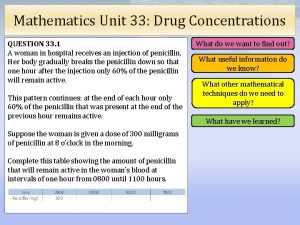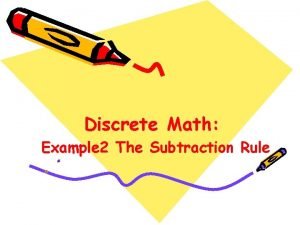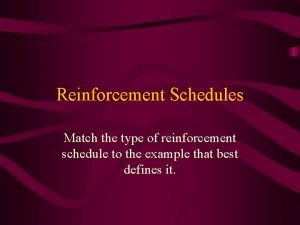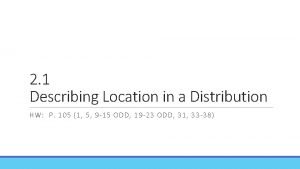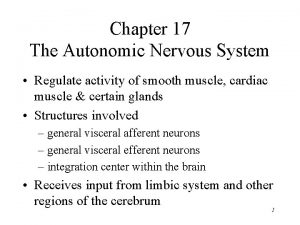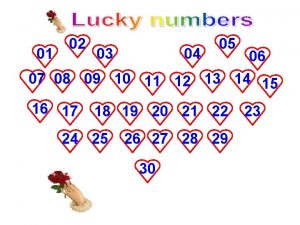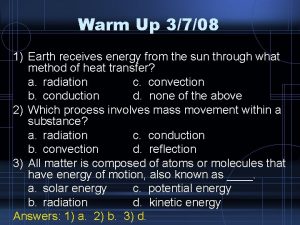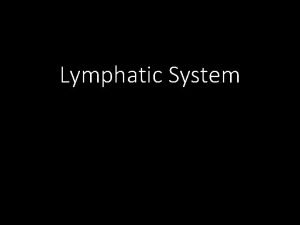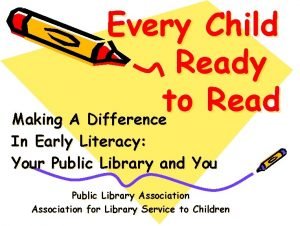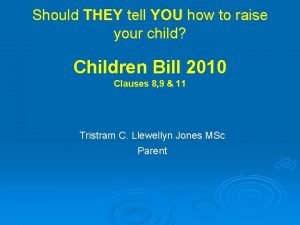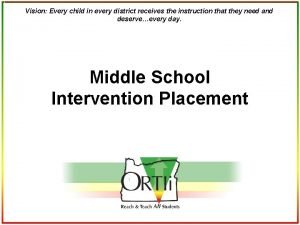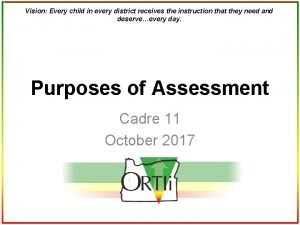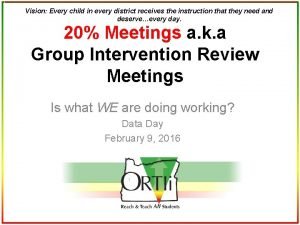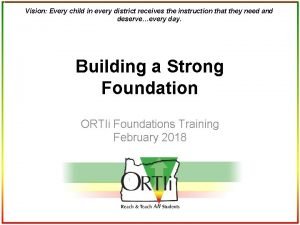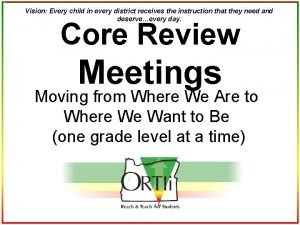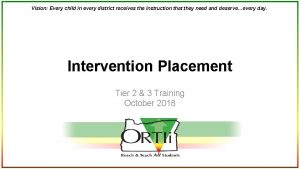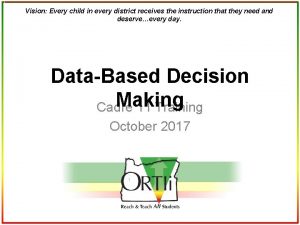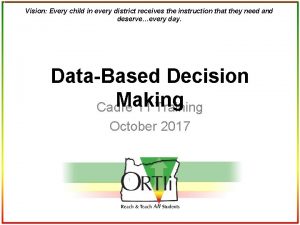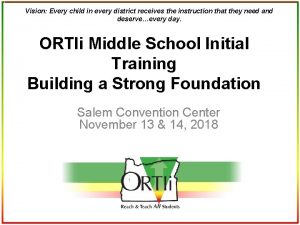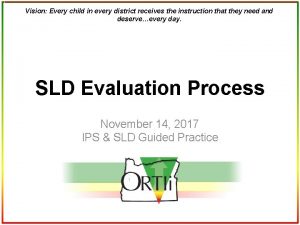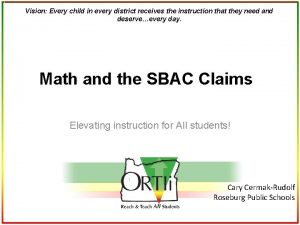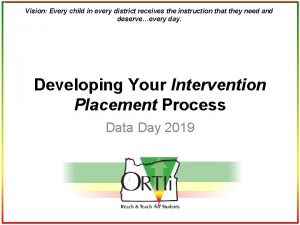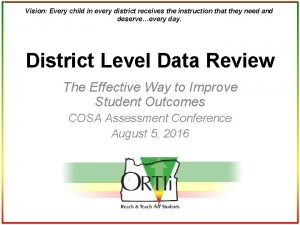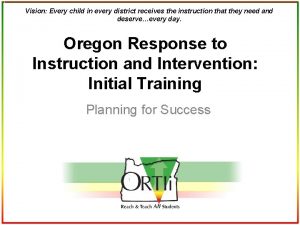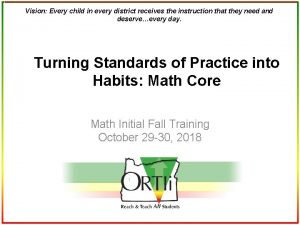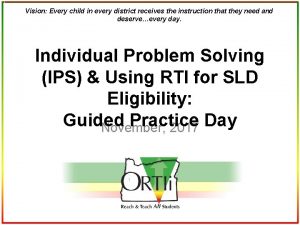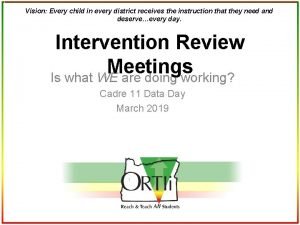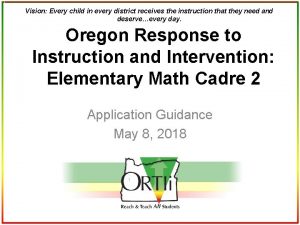Vision Every child in every district receives the





































































- Slides: 69

Vision: Every child in every district receives the instruction that they need and deserve…every day. Planning for Small Group Instruction During Core Reading? Annual Conference 2019 Teresa Lewellen Lisa Bates

General Types Small Reading Group Instruction Skill Focused Guided Reading • Provides opportunities for word work to build fluency • Systematic & explicit • Fast paced • Teacher supports students in identifying words & constructing meaning from text • Teacher monitors students use of skill & strategy • Engages students in thinking about the meaning of the text

Big 5 Area Reading Comprehension Phonics (Alphabetic Principle) Phonemic Awareness Foundational Skills K-5 Vocabulary Constructing Meaning Oral Reading Accuracy & Fluency

Why use small group instruction? • Differentiates instruction based on student need and strategy • Accelerates student growth due to targeted instruction • Provides opportunities to practice, demonstrate learning, & extend learning Benchmark or Above Learners Below Benchmark Learners • Supports students • Provides targeted critical development of the effective skills instruction use of strategies for • Focus on missing skills as processing text well as pre-teaching and reteaching of grade level content from the core

Critical Components of Small Group Instruction • Flexible groups meet based on student need • Every group meets with the teacher every week • High needs students meet with the teacher more often • Practice text at an instructional level • Scaffold students reading so they can practice with support • Focus instruction on specific skills and strategy based upon student need

Small Group Guidelines for Teacher Led Time: Primary & Intermediate Questions Benchmark and Above Strategic Intensive # of students in group? 11 to 13 6 to 10 5 and below *Days per week? Every day One or two days per Two to four days per week Time for each group? 5 to 15 minutes 10 to 15 minutes 15 to 30 minutes Independent practice? Focused on vocab and comprehension skill & strategy Focused on phonics, fluency, vocab and comprehension skill and strategy depending on need Focused on targeted skill needs (typically PA, Phonics, Fluency) * If available IA’s can see non intensive groups for more adult led instruction

Small Group Weekly Example Based on 45 minutes of small group allotted time with IA Primary & Intermediate Monday Tuesday Wednesday Thursday Friday Benchmark IA 15 minutes Teacher 15 minutes Strategic Teacher 15 minutes IA 30 minutes Teacher 15 minutes IA 15 minutes Intensive Teacher 30 minutes IA 15 minutes Teacher 15 minutes IA 30 minutes

Small Group Weekly Example Based on 45 minutes of small group allotted time without IA Based on Grade Level Data Primary Monday Tuesday Wednesday Thursday Friday Benchmark Teacher 10 minutes Teacher 15 minutes Strategic Teacher 15 minutes Teacher 10 minutes Intensive Teacher 20 minutes Teacher 20 minutes Thursday Friday Intermediate Monday Benchmark Tuesday Wednesday Teacher 15 minutes Strategic Teacher 15 minutes Intensive Teacher 30 minutes Teacher 15 minutes Teacher 30 minutes

Core Reading Materials K through 6 th Grade Small Group Whole Group At level reader Below level reader Paired selection 2 Student Book Decodables K-2 Main Anthology selection Above level reader ELL reader

Advised Core Reading Materials K through 6 th Grade Small Group K-2: Decodables Are Priority Standards - All students read decodables first - Read to mastery - After mastering decodables move to leveled reader 3 rd grade does not have decodable text May need to use lower grade level decodables to practice the targeted phonics skills 4 th – 6 th grade may need to use district approved supplemental materials to address phonics skills At level reader Above level reader Below level reader ELL reader K-2 2 Student Book Decodables 2 Take-Home Blackline Master Decodables

Decisions are Made Based on Data: This is Fidelity! • Students are still in the core reading materials during whole group working on vocabulary and comprehension skills/strategies at grade level • Differentiate small group instruction of core reading materials…. – As a team… • • Analyze data Identify target skills Determine what evidence based materials to use Monitor progress and making adjustments as data indicate

Decision Making Process for Small Group 1. 2. 3. 4. Identify skill need Identify instructional routines Identify time spent instructing skill Identify materials

Decision Making Process for Small Group 1. 2. 3. 4. Identify skill need Identify instructional routines Identify time spent instructing skill Identify materials

Decision Making Process for Small Group 1. Identify skill need – Big 5: Quadrant Sort – Target skill 2. Identify instructional routines 3. Identify time spent instructing skill 4. Identify materials

1. Quadrant Sort Likely to Need Core Support: (Benchmark) Accuracy & Fluency (comprehension) Additional support on reading connected text with accuracy: (Strategic) Accuracy & Fluency (accuracy/phonics) Additional support on the fluency of reading connected text skills: (Strategic) Accuracy & Fluency (fluency) Additional support on accurate & fluent reading of connected text: (Intensive) Accuracy & Fluency (PA, phonics, fluency)

1. Quadrant Sort Student Accuracy Fluency Composite/ Intensity Level Miranda 70% 30 Intensive Joey 99% 81 Benchmark Nate 97% 69 Strategic Miles 71% 38 Intensive Addison 88% 45 Intensive Tyler 80% 50 Intensive Andrew 89% 80 Strategic 2 nd grade students (Winter Data)

1. Quadrant Sort: (Benchmark) Accurate & Fluent Student Accuracy Fluency Composite/ Intensity Level Miranda 70% 30 Intensive Joey 99% 81 Benchmark Nate 97% 69 Strategic Miles 71% 38 Intensive Addison 88% 45 Intensive Tyler 80% 50 Intensive Andrew 89% 80 Strategic Joey

1. Quadrant Sort: (Strategic) Accurate & Not Fluent Student Accuracy Fluency Composite/ Intensity Level Miranda 70% 30 Intensive Joey 99% 81 Benchmark Nate 97% 69 Strategic Miles 71% 38 Intensive Addison 88% 45 Intensive Tyler 80% 50 Intensive Andrew 89% 80 Strategic Nate

1. Quadrant Sort: (Strategic) Not Accurate & Fluent Student Accuracy Fluency Composite/ Intensity Level Miranda 55% 30 Intensive Joey 99% 81 Benchmark Nate 97% 69 Strategic Miles 71% 38 Intensive Addison 88% 45 Intensive Tyler 80% 50 Intensive Andrew 89% 80 Strategic Phonics Screener Andrew

1. Quadrant Sort: (Intensive) Not Accurate & Not Fluent Student Accuracy Fluency Composite/Intensity Level 30 Intensive Miranda 70% Joey 99% Nate 97% Miles 71% 38 Intensive Addison 88% 45 Intensive Tyler 80% 50 Intensive Andrew 89% 80 Strategic 81 69 Benchmark Strategic Phonics Screener Miranda, Miles, Addison, Tyler

1. Decision Making Process for Small Group 1. Identify skill need – Big 5: Quadrant Sort – Target skill 2. Identify instructional routines 3. Identify time spent instructing skill 4. Identify materials

1. Identify the target skill need/s? Group Need Benchmark Accurate and fluent Comprehension skill/strategy (CCSS: Reading Literature & Informational) Strategic Not accurate but fluent Phonics (Foundational skills) Strategic Accurate but not fluent Fluency (Foundational skills) Intensive Not accurate and not fluent, PA Phonics and fluency (Foundational skills) Assessment Core assessments Diagnostic phonics assessment (QPS) Universal Screener (DIBELS, easy. CBM) Diagnostic phonics assessment(QPS) PA assessment

1. Identifying Target Phonics Skills adv (Mu anc ltisy ed w o ic w rd w ork ord s) llab 4 or more multiisyllable words (Application of phonics/ decoding strategy) Grade 4 -6 Let Cor ter/So res u pon nd den ce 95% Group

Kindergarten & 1 st Grade Letter names & Sounds 1 st Grade Short vowels VC, CVCC, CCVC 1 st Grade Silent E (CVCe) R controlled vowels

1 st Grade Consonant diagraphs, vowel diagraphs & dipthongs 2 nd Grade Two-Syllable words 3 rd Grade Three-Syllable words 4 th and above Grade Four Syllable words

Sounds/Spellings

Advanced Work: To Be Used to Assess Affixes

Activity 1) Identify Instructional Need

Remember: Quadrant Sort Student Accuracy Fluency Composite/ Intensity Level Miranda 70% 30 Intensive Joey 99% 81 Benchmark Nate 97% 69 Strategic Miles 71% 38 Intensive Addison 88% 45 Intensive Tyler 80% 50 Intensive Andrew 89% 80 Strategic 2 nd grade students (Winter Data)

K & 1 st 2 nd 1 st Miranda 26 10/10 6/10 9/10 7/10 Miranda (text) 26 19/20 9/10 5/10 9/10 7/10 Miles 26 26 10/10 6/10 9/10 7/10 19/20 10/10 5/10 Miles (text) 9/10 7/10 6/10 3 rd 4 -6 th

Activity: Miranda & Miles’ 1. Identify Skill Need: Second grade students

Decision Making Process for Small Group 1. 2. 3. 4. Identify skill need Identify instructional routines Identify time spent instructing skill Identify materials

2. What are Instructional Routines? Uses a structured standard format so that teachers can substitute easier or more challenging topics (e. g. , words or texts) based on the individual needs of the students. Every Instructional Routine is organized in an “I do, We do, You do” format with frequent immediate feedback Areas of Instructional Routines Examples of Instructional Routines PA • Ashlock • Enhanced Core Reading Instruction (ECRI • Core Program Routines Phonics Fluency Vocabulary Comprehension

2. Sound by Sound Blending Routine Example

2. Three-Syllable Words (Intermediate)

Applying Phonics Decoding Strategy: Student Version

2. General Guidelines: Decodable Text (Primary)

Continuum of Phonics Blending Routines Sounds/blending Routines Kindergarten/Early First Grade Sounds: (e. g. , saying letter sounds) 2 Continuous Sound Blending: (mmmaaat) 9 Sounds-spelling/blending First/Second Grade Reading Sound Spellings: (ai, a_e, oy, ar) Sound by Sound Blending: (p, plai, plain) Word reading spelling focused: 7 8 10 (ai, plain) High frequency words Kindergarten/First/Second Grade 3 Introduce words Say it, spell it, say it Reading Words: say the word (building automaticity) Multisyllabic words 3 rd to 6 th grade Blending Multisyllabic Words 10 Application of phonics skills for multisyllabic words 16

Activity 2) Identify Instructional Routines

Activity 2. Identify Instructional Routines: What instructional routines would most address their target skill needs? Things to consider • What phonics skills have they already mastered? • What phonics skills do they need (target skills)? • What instructional routines have they mastered? Second grade students 4 th grade student

Miles & Miranda

Student Sean (3 rd Grade) Accuracy Sean 3 rd Fluency Grader Composite/ Intensity Level Strategic 84% (Strategic) 94% Strategic Sean 1 st K & 1 st Sean 10/10 1010 Sean(text) 10/10 10/10 9/10 2 nd 9/10 7/10 3 rd 5/10 4 -6 th 3/10

Resources

Decision Making Process for Small Group 1. 2. 3. 4. Identify skill need Identify instructional routines Identify time spent instructing skill Identify materials

3. Differences Learning to Read Estimates from NICHD research Population % Journey to Reading Instructional Requirements Need no formal decoding instruction 5 Easy: children read before starting school 35 Relatively Easy Learn to read regardless of instructional approach 40 Formidable Challenge 20 One of the most difficult tasks to be mastered in school Need systematic and explicit instruction Need intensive, systematic, direct, explicit instruction

3. Importance of Active Engagement 90 minutes of instruction = how much growth? How many times it takes to learn something new • Above Average Learner • Average • Truly disabled student Jo Robinson (2008) 4 -14 times 14 -250 times 250 -350 times

3. Plan for the amount of time in specific materials (Guidelines)

Activity 3) Identify Time

Activity 3. Identify Time Spent Teaching Skill Miles & Miranda Sean

Decision Making Process for Small Group 1. 2. 3. 4. Identify skill need Identify instructional routines Identify time spent instructing skill Identify materials

4. Core Program Primary Materials Core Materials Primary time of Purpose instruction Anchor Whole group Text/Anthology Teach vocabulary, comprehension skills/strategies Decodables/ Shared Read (K-2) Leveled Readers Whole group Small group Build phonics & fluency Small group Practice skill/strategy and build fluency/vocab * Text Types Resource

Reteach & practice grade level or slightly lower skills Practice grade level skills Intensity of instruction Intensity of materials Catch Up Growth

4. How do you adjust intensity? Intensity of materials Intensity of instruction • Explicit and systematic • The 5 Mores – More Explicit – More Modeling – More Time – More Practice – More Monitoring & Feedback

4. Benchmark/Above Students What core materials are available and are they sufficient? “No” yes Above Leveled Reader Extend with more complex literature Use decodables (K-2) Anchor Text Paired Selection Leveled Readers

4. Strategic Students What core materials are available and are they sufficient? yes • Use core program suggestions for small group • Leveled Readers • Below and/or On • Preteach/reteach • “The 5 Mores” No • Below Leveled Readers • Increase focus on PA, Phonics, and/or Fluency • Instructional Routines • Explicit Phonics Lesson • “Intervention kit” • Preteach/reteach • “The 5 Mores”

4. Intensive Students What core materials are available and are they sufficient? yes • • • Decodable Text Below Leveled Readers Instructional Routines Explicit Phonics Lesson Preteach/reteach “The 5 Mores” No • Decodable text (from lower grade level) • Instructional Routines • Explicit Phonics Lesson • Supplemental materials • Replacement Core • (Leveled Reader: read to them) • Preteach/reteach • “The 5 Mores”

Activity 4) Identify Materials

Activity 4) Identify Materials Miles & Miranda Sean Things to consider • Scope and sequence of 2 nd grade core materials • Grade level long vowel sounds & silent e are mastered

Skill Need Instructional Routines Time Materials Miles & Intensity: Level/Composite: Miranda Intensive Sounds: Sound Spellings Blending: Sound by Sound Blending Decodable Text: Word Reading by Sentence foundational skills 4 to 5 days comprehension /vocabulary skills 0 or 1 day Foundational Skill decodable text from first grade with lots of OTRs Comprehension/ Vocabulary leveled reader with teacher reading to them Sean Blending Multisyllabic Words (#10) Leveled Reader Application of phonics skills for multisyllabic words (#16) foundational skills 2 to 3 days comprehension /vocabulary skills 2 or 3 days Foundational Skil Reteach multisyllabic skills Leveled Reader with focus on reading for accuracy and fluency Comp/Vocab Approaching Leveled Reader with focus on comprehension and vocabulary Big 5 Area: Phonics Target Skill: long vowels & silent e Intensity: Level/Composite: Strategic Big 5 Area: Phonics Target Skill: three syllable multisyllabic

Planning for Small Group Instruction s e c r u so Re Tim e Critical for Student Success! Mat erial s C g n i g n e l l ha

Take Small Steps

Identifying Target Phonics Skills adv (Mu anc ltisy ed w o ic w rd w ork ord s) llab 4 or more multiisyllable words (Application of phonics/ decoding strategy) Grade 4 -6 CCSS: Foundational Skills Phonics (95% Group)

Instructional Routines Resources • Enhanced Core Reading Instruction (ECRI) – https: //dibels. uoregon. edu/market/movingup/ecri/ • Oregon Reading First (Templates) – Powerpoint • https: //cse. google. com/cse? ie=UTF 8&q=template+cards&sa=Search&cx=0173054107670 41818694%3 Augyerevfwve • Ashlock – https: //www. cde. state. co. us/sites/default/files/doc uments/coloradoliteracy/clf/downloads/instruction al_templates. pdf

Instructional/Practice Resources • Florida Center for Reading Research – https: //fcrr. org/resources_sca. html • National Center for Intensive Intervention – https: //intensiveintervention. org/interventionresources/literacy-strategies#phonics

Contact Information • Teresa Lewellen, Literacy Consultant – Teresa. Lewellen@icloud. com • Lisa Bates, ORTIi – lbates@ttsd. k 12. or. us

Answers: 1. Identify Skill Need (Miranda & Identify Skill Need Intensity Level/Composite? Big 5 Area: Quadrant Sort? Target Skill? Miles) Miranda: intensive level (30 wcpm/70% accuracy) Miles: intensive level (38 wcpm/71% accuracy) 2 nd Grade Winter Benchmark: 72 wcpm/96% accuracy Phonics (Accuracy &Fluency) • Long Vowel Sounds & Silent e • Any other first grade skills not mastered (e. g. Dipthongs)

Answers: 2. Identify Instructional Routine/s 2) Identify Instructional Routines Sounds-spelling/blending • Sound spellings (#7) • Sound by sound blending (#8) Decodable text • Decodable text routines (#12/13) Multisyllabic Words • Blending Multisyllabic Words (#10) Leveled Reader • Application of phonics skills for multisyllabic words (#16)

Answers: 3. Identify Time Spent Teaching Skill Foundational Skills Comprehension/ Vocabulary Skills Miles & Miranda 4 -5 days 0 -1 day Sean 2 -3 days

Answers: 4) Identify Materials Skill Need Skill Focused Materials (Foundational) Guided Reading Materials (Comp/vocab strategy) Miles & Miranda Phonics Intensive • Long Vowel Sounds & Silent e Decodable text containing long vowel/silent e from first grade core Struggling/ Approaching Leveled Reader (read to students) Sean Phonics • 3 syllable multisyllabic • Reteach multisyllabic skills • Leveled Reader with focus on reading for accuracy and fluency Struggling/ Approaching Leveled Reader with focus on comprehension and vocabulary
 Every child every day
Every child every day Structured light
Structured light Child vision foundation
Child vision foundation Left child right child tree representation
Left child right child tree representation A woman in hospital receives an injection of penicillin
A woman in hospital receives an injection of penicillin A computer company receives 350 applications
A computer company receives 350 applications A blueberry picker receives $1 after filling 3 pint boxes.
A blueberry picker receives $1 after filling 3 pint boxes. Tribeculated
Tribeculated A wise man receives correction
A wise man receives correction The left side of the heart receives blood from the
The left side of the heart receives blood from the Mark receives a score report detailing his performance
Mark receives a score report detailing his performance Comic relief literary definition
Comic relief literary definition The cuban melodrama
The cuban melodrama Which target organ receives dual innervation
Which target organ receives dual innervation Ms jones isn't as nice ms smith
Ms jones isn't as nice ms smith When earth receives energy from the sun, ____.
When earth receives energy from the sun, ____. Right atrium
Right atrium Pouchlike structure at the start of the thoracic duct
Pouchlike structure at the start of the thoracic duct What receives the most solar radiation
What receives the most solar radiation Short tube that receives purified lymph
Short tube that receives purified lymph Every child ready to read six skills
Every child ready to read six skills Every child a seed
Every child a seed Every mother loves her child tag question
Every mother loves her child tag question Why was every child matters scrapped
Why was every child matters scrapped Every child matters be healthy
Every child matters be healthy Orange shirt day quotes
Orange shirt day quotes Every child is gifted they just unwrap
Every child is gifted they just unwrap Every child a seed
Every child a seed Pta every child one voice
Pta every child one voice Every knee shall bow every tongue confess
Every knee shall bow every tongue confess Every rotarian every year
Every rotarian every year Every nation and every country has its
Every nation and every country has its Every nation and every country
Every nation and every country Microsoft vision statement
Microsoft vision statement Every picture has a story and every story has a moment
Every picture has a story and every story has a moment Vẽ hình chiếu vuông góc của vật thể sau
Vẽ hình chiếu vuông góc của vật thể sau Phép trừ bù
Phép trừ bù Tỉ lệ cơ thể trẻ em
Tỉ lệ cơ thể trẻ em Lời thề hippocrates
Lời thề hippocrates Vẽ hình chiếu đứng bằng cạnh của vật thể
Vẽ hình chiếu đứng bằng cạnh của vật thể đại từ thay thế
đại từ thay thế Quá trình desamine hóa có thể tạo ra
Quá trình desamine hóa có thể tạo ra Công thức tính độ biến thiên đông lượng
Công thức tính độ biến thiên đông lượng Các môn thể thao bắt đầu bằng tiếng chạy
Các môn thể thao bắt đầu bằng tiếng chạy Sự nuôi và dạy con của hổ
Sự nuôi và dạy con của hổ Thế nào là mạng điện lắp đặt kiểu nổi
Thế nào là mạng điện lắp đặt kiểu nổi Hình ảnh bộ gõ cơ thể búng tay
Hình ảnh bộ gõ cơ thể búng tay Dạng đột biến một nhiễm là
Dạng đột biến một nhiễm là Biện pháp chống mỏi cơ
Biện pháp chống mỏi cơ độ dài liên kết
độ dài liên kết Gấu đi như thế nào
Gấu đi như thế nào Thiếu nhi thế giới liên hoan
Thiếu nhi thế giới liên hoan điện thế nghỉ
điện thế nghỉ Một số thể thơ truyền thống
Một số thể thơ truyền thống Trời xanh đây là của chúng ta thể thơ
Trời xanh đây là của chúng ta thể thơ Thế nào là hệ số cao nhất
Thế nào là hệ số cao nhất Hệ hô hấp
Hệ hô hấp Lp html
Lp html Số nguyên là gì
Số nguyên là gì Phối cảnh
Phối cảnh đặc điểm cơ thể của người tối cổ
đặc điểm cơ thể của người tối cổ Các châu lục và đại dương trên thế giới
Các châu lục và đại dương trên thế giới Tư thế worm breton là gì
Tư thế worm breton là gì ưu thế lai là gì
ưu thế lai là gì Tư thế ngồi viết
Tư thế ngồi viết Cái miệng nó xinh thế
Cái miệng nó xinh thế Mật thư tọa độ 5x5
Mật thư tọa độ 5x5 Các châu lục và đại dương trên thế giới
Các châu lục và đại dương trên thế giới Bổ thể
Bổ thể Tư thế ngồi viết
Tư thế ngồi viết




